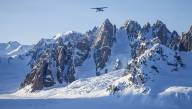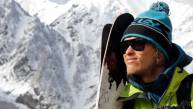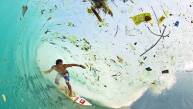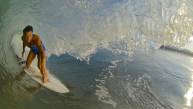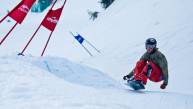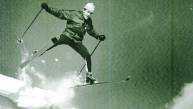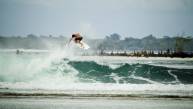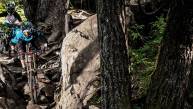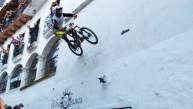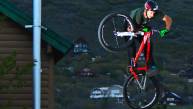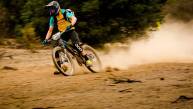tags:
Peru |
urban downhill |taxco urban downhill |remar orphanage |philanthropy |peru |high fives |freeride |chris van dine |chile |bike |athlete humanitarian work
Chris Van Dine is a hard guy to track down. The thirty-four year-old mountain biker from the backwoods of Pennsylvania has been motopacking and adventure riding through Central and South America for weeks. Or maybe months. For Van Dine, time is seemingly irrelevant after so many trips to this part of the world throughoutthe last seven years.
Frustrated with contests, sponsors, injuries, and relationships last season, Van Dine started his spring below the equator on a soul-seeking trek as raw and unpredictable as the places he’s visited. We tracked down Van Dine—who was posted up at a hostel in the sacred Inca village of Ollantaytambo, Peru—and discussed the spirit of adventuring, the growth of urban downhilling, and the role of bikes in developing countries.
 Any kid would kill to be poppin' wheelies with Chris.
Any kid would kill to be poppin' wheelies with Chris.
Where have you found inspiration on this trip?
When I’m on the motorcycle and there’s wind in my face and tunes in my ears, that’s when the good inspiration hits me. Motorcycles, bikes, and music are a great combination. That’s living for me. That’s about as alive as I get.
What does that mean for this coming bike season?
I’m excited. I feel like this could be the biggest year for me. Not as a rider necessarily. I don’t care about the career. But as far as the impact goes, and what my heart is saying, and not trying to justify or explain things to people. . .
Check out Chris sessioning a wall ride and then exploring Valpo, Chile with Aaron Chase and Brian Lopes.
In a video edit from Valpo, Chile last fall, you mentioned the importance of getting lost and finding your own way. Are you living by your own advice?
That’s one of my favorite things to do. In new cities, I love to take off on my bike at night and explore. Every night you find amazing stuff. Not just riding features, but local soccer matches and cool, real-deal local stuff. People look at you differently as a tourist when you’re on a bike than when you’re in a tour bus. You’re on the ground with people and get to experience what the culture is like. That’s part of the magic of bikes. It takes you away from your normal routine.
I feel like this could be the biggest year for me. Not as a rider necessarily. I don’t care about the career. But as far as the impact goes, and what my heart is saying, and not trying to justify or explain things to people. . .
You’ve been involved with the urban downhill scene in South and Central America since 2007. How have you seen this discipline evolving?
Course design and infrastructure are a big deal, and that’s a huge stumbling block for these places like Taxco [Mexico] and Valpo and Santos [Brazil]. They know it’s gonna be a huge success, but they’re not willing to make the investment in quality features. Taxco is really leading the way with that, though. It’s been a big success, and now there’s a demand from other cities that want to get into urban racing.
 The way to travel with a bike in South America--assuming you're not always riding it.
The way to travel with a bike in South America--assuming you're not always riding it.
What are the biggest differences you’ve seen in downhill races between North America and South America?
The fans here gravitate towards style and flair. They don’t want a robotic champion who doesn’t have panache. That’s magnified in urban races, especially on courses that allow racers to do backflips or huge wall rides on their runs. You know, it’s not just about the results. In racing, there just hasn’t been a whole lot of weight on the showmanship and style. You’re just trying to out-pace the guy next to you. I respect that, but I’m way more about the technical stuff.
Have you had any close encounters with people/animals/objects when you’re racing an urban course?
There are always hazards. That’s just how it is down here. Every time I throw a leg over a bike, there’s a close encounter. Once I came out of this blind roller and landed right on a dog’s tail. I saw him at the last second. The dog freaked out and took the next three racers out. That happens on most runs. But a good downhill run is always on the edge. It’s not mud ruts and rock gardens here. There are a lot of people and noise and old ladies walking from the panadería, so the course moves a little more.
 Such goof balls.
Such goof balls.
What’s this partnership with an orphanage in El Salvador all about? Presumably doing something involving bikes?
Yeah, it’s called Remar Orphanage. It’s an enlightening place to be. The kids are so positive and uplifting. I proposed to get a public pumptrack going, find a sustainable way to get more bikes out there, and help build up a bike mechanic school. The more bikes there are in a country, the more bike mechanics they need. It’s a cool way to create jobs for the economy. It’s made kids realize that having a bike is a huge opportunity.
To climb deeper inside Chris' head, check out this edit from 2012--even back then, he had a vision for where he'd be today.



